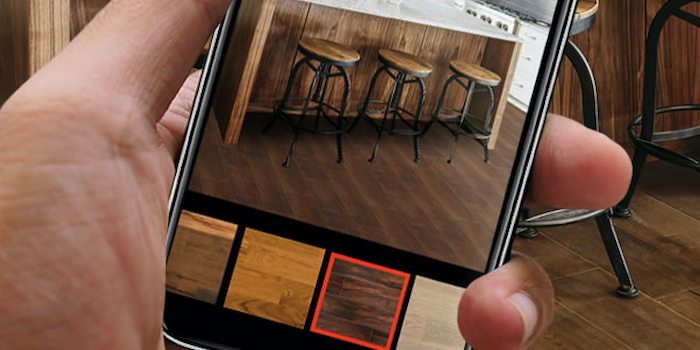Technology
AR and VR tools offer a new reality
Thursday, August 23, 2018
 Here, a user utilizes MSI’s AR tool, which is mobile friendly.
Here, a user utilizes MSI’s AR tool, which is mobile friendly.
By Teresa O’Dea Hein
Augmented reality (AR) and virtual reality (VR) tools are moving beyond gaming and social media filters to enable consumers to feel better about their purchasing decisions.
Narrowing down the broad spectrum of product choices can be a tough task for many flooring shoppers. Now, with the help of AR and VR tools, more and more retail sales associates (RSA) will be able to show consumers how a flooring option would look in a specific room. These new technologies can bridge physical reality with a customized digital reality. It’s almost like taking a floor on a “test drive.”
A number of other categories of retailers are already taking advantage of the potential posed by these literally ground-breaking technologies. “We only have to look at the many companies currently utilizing AR/VR to see how it is impacting the retail space,” said Misty Hodge, director of digital marketing residential platforms for Shaw Floors. “Companies like Ikea, Warby Parker, Nike, Wayfair, Audi and Lowe’s are each integrating this technology in their retail experience.
“This trend is only going to grow in the coming years,” Hodge predicted. “Soon, it will not be whether dealers are utilizing AR/VR methods or not, but how they are doing so.”
Framarz Mistry, director of design technology at Mohawk Group, reported, “VR will be a major direction that designers are going to move in; it’s the most immersive way to experience a space and our products. VR provides a spatial understanding of building design — for example, is an area too narrow? With a 360-degree image on a cell phone or tablet, you can walk around a space that doesn’t even exist,” he explained, adding, “Better visuals can lead to better decisions.”
“By utilizing augmented or virtual reality, brick-and-mortar dealers can elevate their showroom experience to the next level.”— Misty Hodge, director of digital marketing - residential platforms, Shaw Floors
What it really means
What is the difference between VR and AR?
Virtual reality (VR) transports a viewer, via closed visors or goggles, to another place whereas augmented reality (AR) takes our current reality and adds something to it, like new flooring options. AR is a mainstay on Snapchat and Instagram filters as well as in games like Pokémon Go.
“While VR is more immersive, AR provides more freedom for the user and more possibilities for marketers because it does not need to be a head-mounted display,” said Coby McDougal, national key account sales representative at MSI.
“I believe that the demand for technology-based solutions is growing at the same rate as is consumer demand to participate more heavily in the planning stages of their surfaces project,” McDougal added. “Consumers want someone to ‘paint them a virtual picture’ of their project. They want to see scaled drawings, which fully specify color, format, pattern, etc.
“In order for this demand to be met, the everyday RSA is being called to understand/embrace all levels of technology available to them in the marketplace,” he pointed out. “Currently, this technology is being delivered through proprietary/integrated field measurement systems, as well as the more traditional planning/drafting software solutions such as Revit and AutoCAD. The world is changing and AR will become an enormous piece of telling the story of products and services being sold today,” McDougal said, adding, “AR and visualizer tools allow the consumer to make a decision based on logic versus trial and error/emotion.”
Clearly, there is a strong interest in what this technology can deliver. The launch of MSI’s AR visualizer proved that as it was used several hundred times per day in its first month, according to MSI co-president Rupesh Shah. It does not require the user to download an app.
“The MSI visualizer works best on a phone or iPad because you can take the picture in real time, without having to upload it on a computer,” McDougal explained. “Also, in the showroom, MSI’s products carry QR codes, which will show the product in real time on a pre-existing image or on a picture you take right on the spot.”
Added Shah, “Consumers want instant gratification and any tool must be simple and easy to use but provide functionality.”
Available options include selecting a different sized tile, rotating the tile 90 degrees or selecting a new product or filter by look, color or material type — all without leaving the rendered room scene.
“The world is changing and AR will become an enormous piece of telling the story of products and services being sold today.” — Coby McDougal, national key account sales representative, MSI
Early adopters
Manufacturers have found that dealers are open to incorporating this new technology. “When demonstrating our 2017 prototype in our convention and markets,” Hodge recalled, “dealers could see situations in which leveraging this technology would benefit their customers and were eager to eager to include the prototype in their business immediately. This exciting technology shows customers that dealers are willing to invest in their buying journey. VR/AR technology is advancing rapidly and increasing in popularity,” she said.
MSI’s McDougal added, “I think that this adoption of the relevance of technology, as it relates to flooring, is key to serving the ever-changing needs of the consumer. Remember, the biggest luxury that people have is time. It is up to us to learn how to better anticipate and respond to consumer demand…and technology is one more way to do just that. We believe this technology will both drive sales at the retail level as well empower the consumer in the decision-making process...eliminating guesswork and closing the sale,” he pointed out.
Supporting store traffic
“As a manufacturer, one of our responsibilities is ensuring we equip our dealers with the right tools for their success,” Hodge said. “We are using AR/VR ultimately to help elevate the consumer’s excitement in their flooring project and find confidence in their decision. Consumers are often overwhelmed by the floor-buying process,” she noted. “Purchasing flooring can be a major investment, and consumers often feel pressure to ‘get it right.’ By providing AR/VR tools for our dealers, we’re able to help make the experience easier and more impactful so consumers will continue visiting the retailer for their flooring needs,” Hodge said.
On the retail sales floor, she continued, “AR/VR technology can help show the buyer a real-time application of products they are considering for their own spaces. If they can truly experience this floor instead of trying to imagine it, the possibilities are endless. With this technology, consumers no longer have to wonder what a product will look like in their home — they can see it and feel confident in their purchasing choices. AR/VR technology combines digital and physical shopping experiences, while also making the buying process fun for consumers.”
“VR is a better way of visualizing an image. Better visuals can lead to better decisions.”— Framarz Mistry, director of design technology at Mohawk Group
As well, Hodge explained that consumers can take a VR tour on their computer, phone or virtual reality headset, touring each room to view Shaw’s products without ever leaving the comfort of their home.
“This technology takes away the guesswork and uncertainty that consumers often face with purchasing decisions,” offered Hodge. “By utilizing augmented or virtual reality, brick-and-mortar dealers can elevate their showroom experience to the next level.”
Field Tested
Wholesale Flooring & Granite in Baton Rouge, La., has been using MSI’s augmented reality (AR) tool for a couple of months. “Customers love it and so do our salespeople,” said Arianna Gillespie, executive assistant. “It makes it a lot easier for customers.to get a much better idea of how a tile will actually look in their home.”
Usually, Gillespie added, “it’s the color that people are undecided about. Since people can’t take our tile samples home, that’s no longer an issue with this tool. This new tool is making customers feel more comfortable with their decisions,” she reported. “People are pleasantly surprised that we offer a tool like this — it’s really impressive.”
Wholesale Flooring & Granite already offered an online virtualizer where customers can test out wall colors and granite countertops.
“People like that this AR tool isn’t an app and that it doesn’t require they give it access to their phone and their camera,” Gillespie pointed out. “Half the people use it in the showroom while the other half use it at home and when they come back, they tell us how much they love it.”
Going forward, Adam Pace, chief financial officer at Metro Floors in Lancaster, Calif., believes AR/VR will be a great selling tool to let customers really get a view of what the product will look like in their home. “They won't have to worry about making the correct decision as far as color and/or style since they can see it in their own rooms. It helps relieve the large purchase anxiety,” he said.
However, Pace worries about the potential flip side of these advances. ”One thing that is scary about the technology, though, is that it will aid more so in ‘e-tailing,’ where customers can see the finished product in their home without having to go a flooring retailer.”
By the Numbers
American awareness of virtual reality and augmented reality devices nearly doubled between 2016 and 2017. — Mediakix
More than 24 million augmented and virtual reality devices will be sold in 2018. — CCS Insight
In 2022, the augmented and virtual reality market is expected to reach $209.2 billion. — Statista
22.4 million Americans experience virtual reality at least once a month. This year, the number of U.S. virtual reality users is predicted to grow to 36.7 million — over a 60 percent increase in just one year. — Mediakix
Amazon has over 2,000 products listed under the category “virtual reality headset.”
The number of active virtual reality users is projected to increase to 171 million this year. — Statista
FCW Live
Welcome to Floor Covering 101


COVID-19 Communications

Greenbuild Conference
November 12 - November 15, 2024
Washington, D.C. - Walter E. Washington Convention Center